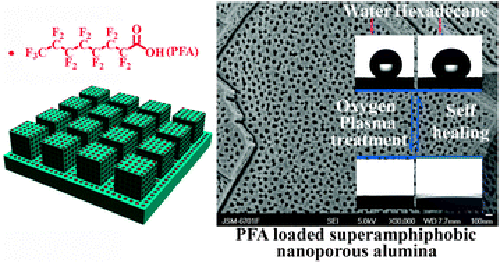| News |
| ・Events |
| ・Int’l Cooperation News |
| ・Upcoming Events |
| Location: Home>News>Events |
| Self-healing Superamphiphobicity Highlighted by Nature Asia-pacific |
| ||||||
|
|
The surface/interface research group from the Lanzhou Institute of Chemical Physics of the CAS has developed self-healing surface that can recover its water- and oil-repelling qualities after damage (Chem. Commun., 2011, 47, 2324–2326). The work was highlighted by Nature Asia-pacific in the recent issue (NPG Asia Materials featured highlight | doi:10.1038/asiamat.2011.60). In recent years, although the artificial superamphiphobic surfaces are successfully fabricated in overwhelming ways, their applications are limited by low durability in practice. Moat manmade superamphiphobic surfaces are very weak since their fine and delicate structures are liable to mechanical wear and harsh conditions. They lost superamphiphobicity in a short period of time and their self-cleaning function is very limited. Nature uses a genetically formed scaffold and consecutively releases simple wax-like materials to achieve superhydrophobicity that is usually preserved very well by mother biospecies because both complicated surface structures and the low surface energy coating can be recovered or refreshed after damage. Therefore, discovery of superamphiphobic surfaces with long durability is of great significance. The team has demonstrated a facile and feasible approach to achieve a self-healing superamphiphobic (both superhydrophobic and superoleophobic) surface under mild conditions. The superamphiphobic surface was obtained by filling perfluorooctyl acid into the nanopores of anodized alumina, which was then treated with O2 plasma to damage its superamphiphobicity. The damaged surface can automatically heal its superamphiphobicity in 48h at room temperature by the release and enrichment of perfluorooctyl acid loaded in nanopores onto the top surface. The nanopores serve as the nanoreserviors for perfluorooctyl acid to release and recover the surface after the low surface energy coating of the outmost surface was damaged. The approach is distinctive in its use of simple ingredients, ease of application, mild conditions of self-healing superamphiphobicity and applicability to many types of materials with nanopores or microvascular networks. The work has received support from the National Natural Science Foundation of China. The detailed report has been published in Chem. Commun.(Chem. Commun., 2011, 47, 2324–2326).
PFA loaded superamphiphobic nanoporous alumina (Image by ZHOU Feng et al.)
Nature Asia-pacific has highlighted the work. http://www.natureasia.com/asia-materials/highlight.php?id=890
Link to highlighted article:Nature Asia-pacific
|

